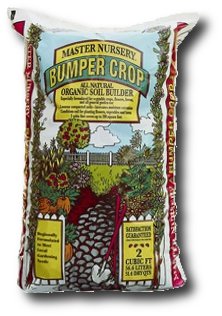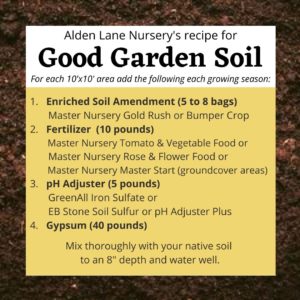Gardening is not just about taking care of plants; it is about taking care of the soil. Good garden soil has texture, moisture, oxygen, nutrients, and microbial life. If everything adds up below the ground, your plants will probably thrive without much additional effort from you.
Throughout a year, nutrients are used up, and soil organisms break down organic matter in the soil. Now is an excellent time to add compost fortified with chicken manure. Doing so restores the organic matter and nutrients in the soil while improving texture.
 Three to four inches of Bumper Crop worked into the top 8″ of soil will yield a 9-12″ deep layer of suitable garden soil that drains well, nurtures life and produces a respectable garden harvest. Ongoing care of the soil will result in a garden that produces better and better as the years unfold.
Three to four inches of Bumper Crop worked into the top 8″ of soil will yield a 9-12″ deep layer of suitable garden soil that drains well, nurtures life and produces a respectable garden harvest. Ongoing care of the soil will result in a garden that produces better and better as the years unfold.
Good Garden Soil Starts Here!
If you are preparing a vegetable or flower garden bed here’s a tried-and-true soil preparation recipe that works wonders. It lightens our heavy soil, nourishes it and buffers the pH to make it ‘just right’ for the success of your vegetable and flower seeds or transplants.
Good Soil Tips
The following is a to do list that can help you nurture your soil:
- Plant in a Raised Bed: Improves drainage, helps warm the soil.
- Incorporate Organic Material: It acts as a wedge to hold clay soil open and allows water to drain more freely and permit air to occupy more of the space between soil particles.
- Incorporate Gypsum: Helps leach salts from the soil, adds calcium and relaxes the clay.
- Add Mulch: Apply 3″ of bark or Bumper Crop to reduce weeds, save water and moderate soil temperatures.
- Improve Nutrients: Fertilize with a mild fertilizer which includes micro-nutrients (EB Stone Organics, Maxsea). Micronutrients are essential for healthy plant development and are sometimes missing from soils.
- Water Appropriately: Water thoroughly but infrequently enough so that air is allowed back into the soil between waterings, usually only every 3-10 days depending in the weather.
- Use an inexpensive Moisture Meter to judge soil moisture more accurately.

